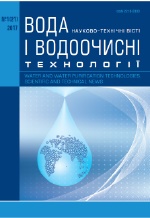The removal of indigo carmine from water by solvent sublation
DOI:
https://doi.org/10.20535/2218-93002112017121431Keywords:
dye, indigo carmine, hexadecylpyridinium bromide, solvent sublation, spectrophotometryAbstract
In this research, which includes the previously published works of this team on dyes removal, solvent sublation was applied in order to remove such dyestuff as Indigo carmine from model solutions. The aim of the work was to study the main principles of Indigo carmine removal from water by solvent sublation. Indigo carmine (IC, C16H8N2Na2O8S2), an anionic dye, was removed from aqueous solutions by solvent sublation of an IC–hexadecylpyridinium bromide (HPB) complex (sublate) into octanol. The effects of the following parameters on solvent sublation were experimentally studied: the molar ratio of HPB:IC, pH of aqueous phase, duration of the removal process, type and volume of organic solvent. The initial dye concentration was 10 mg/dm3. It was found that the process should be conducted under such conditions: pH 5, solvent – octanol, Schott filter nominal pore size – 16 μm, molar ratio of HPB:IC = 1:1, process duration – 20 min. According to obtained results the highest level of IC elimination that was reached within the experiment equals 95,5%.References
Forgacs E., Cserha T., Oros G. Removal of synthetic dyes from wastewaters: a review. Environment International, 2004, 30, pp. 953 — 971.
Nesterova L., Saribekov H. The efficiency of the use of circulating water consumption systems in textile plants. South-European Journal of Advanced Technologies, 2010, 4/8 (46), pp. 25—28.
Singh L., Singh V.P. Biodegradation of Textile Dyes, Bromophenol Blue and Congored by Fungus Aspergillus Flavus. Environ. We Int. J. Sci. Tech., 2010, 5, pp. 235— 242.
Robinson T., McMullan G., Marchant R., Nigam P. Remediation of dyes in textile effluent: a critical review on current treatment technologies with a proposed alternative. Bioresource Technology, 2001, 77, pp. 247— 255.
Bi P., Dong H., Dong J. The recent progress of solvent sublation. Review. Journal of Chromatography A, 2117 (2010), pp. 2716 — 2725.
Sobianowska K., Walkowiak W., Kozłowski C. Principles and application of solvent sublation - a Review. Ars Separatoria Acta, 7(2009/2010), pp.23 — 38.
Lu Y. Wang Y., Zhu X. The Removal of Bromphenol blue from Water by Solvent Sublation. Separation Science and Technology, 2001, 36 (16), pp.3763 — 3776.
Astrelin I. M., Obushenko T. I., Tolstopalova N. M., Targonska O. O. Teoretichni zasadi ta praktichne zastosuvannja flotoekstrakciyi: ogljad. Water and water purification technologies, 2013, no. 3, pp. 3—23.
Obushenko T., Tolstopalova N., Kulesha O., Astrelin I. Remediation of anionic dye (Bromphenol blue) from aqueous solutions by solvent sublation. "Science news" KPI ", Issue Problems of Chemistry and Chemical Technology, 2015, no. 2, pp.125—133.
Obushenko T.I., Tolstopalova N.M., Bolielyi A.S. Solvent sublation of methylene blue from water. European science, 2017, no. 4 (26), pp.10—13.
Obushenko T.І., Astrelіn І.M., Tolstopalova N.M., Batjuk V.O. Solvent sublation of dyes from wasterwater. Eastern-European Journal of Enterprise Technologies, 2012, no. 2/14 (56), pp. 68—72.
Obushenko T.I., Tolstopalova N.M., Astrelin I.M. Removing Synthetic dyes from wastewater. Science Rise, 2016, Vol.5, no. 2 (22), pp. 47—53.
Obushenko T., Tolstopalova N., Kulesha O., Astrelin I. Thermodynamic studies bromphenol blue removal from water using solvent sublation. Chemistry & chemical technology, 2016, Vol. 10, no. 4, pp.515—518.
Downloads
Published
How to Cite
Issue
Section
License
Copyright (c) 2020 T. Obushenko, N. Tolstopalova, Y. Kholmetska

This work is licensed under a Creative Commons Attribution-NonCommercial 4.0 International License.
The ownership of copyright remains with the Authors.
Authors may use their own material in other publications provided that the Journal is acknowledged as the original place of publication and National Technical University of Ukraine “Igor Sikorsky Kyiv Polytechnic Institute” as the Publisher.
Authors are reminded that it is their responsibility to comply with copyright laws. It is essential to ensure that no part of the text or illustrations have appeared or are due to appear in other publications, without prior permission from the copyright holder.
WPT articles are published under Creative Commons licence:
- Authors retain copyright and grant the journal right of first publication with the work simultaneously licensed under CC BY-NC 4.0 that allows others to share the work with an acknowledgement of the work's authorship and initial publication in this journal. The use of the material for commercial purposes is not permitted.
- Authors are able to enter into separate, additional contractual arrangements for the non-exclusive distribution of the journal's published version of the work (e.g., post it to an institutional repository or publish it in a book), with an acknowledgement of its initial publication in this journal.
- Authors are permitted and encouraged to post their work online (e.g., in institutional repositories or on their website) prior to and during the submission process, as it can lead to productive exchanges, as well as earlier and greater citation of published work.

